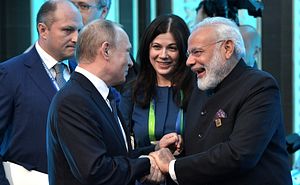When Indian Prime Minister Narendra Modi and Russian President Vladimir Putin had an “informal” meeting in Sochi in late May, the two leaders discussed a number of bilateral issues such as military and defense cooperation and international issues relevant to both India and Russia. The meeting once again put the attention on the strategic partnership between New Delhi and Moscow, which continues to be significant, but also faces a number of challenges.
Many of the areas of convergence were unsurprisingly on display during the meeting at Sochi. In terms of outlook, the two leaders endorsed and emphasized the importance of their Special and Privileged Strategic Partnership for global peace and stability and the role of the two in shaping “an open and equitable world order.” Both Modi and Putin underlined the need to develop “a multipolar world order” while increasing consultations and coordination including on the Indo-Pacific, even though the two sides differ in their characterization. Foreign Minister Lavrov, while speaking to the media on the informal summit, talked about it as the Asia-Pacific region, a formulation preferred by China, whereas the Indian Ministry of External Affairs referred to it as the Indo-Pacific region. Putin and Modi also reiterated the importance of continuing their work together in platforms such as the United Nations, Shanghai Cooperation Organization (SCO), Brazil, Russia, India, China, South Africa (BRICS), and G-20.
Issue-wise, cooperation in the energy and economic sectors dominated the two leaders’ discussions. The progress seen in the bilateral trade – about 20 percent in 2017 and about 40 percent in the first few months of 2018 – was highlighted by both sides. In an effort to keep up the momentum, the NITI AAYOG and the Russian Ministry of Economic Development will be engaged in an annual strategic economic dialogue.
Nevertheless, it is the civil nuclear energy and defense cooperation that will dominate the relationship. The technical aspects for the construction of the fifth and sixth units of the Kudankulam nuclear power plant (NPP) have been finalized by Rosatom. During a recent visit to the NPP manufacturing site in Rostov sponsored by Rosatom, I was able to witness the progress of these including the units that will be transported to Kudankulam.
More fundamentally, while the two leaders highlighted the tried and tested nature of their partnership, in truth India-Russia ties have been lately going through a rough patch. For more than a decade now, the bilateral relationship has been characterized by increasing strains.
Several factors have contributed to it. For one, in the wake of the Ukraine crisis in 2013, it is clear that Russia wanted China’s support because China’s opinion carries greater weight globally than India’s. This is evident in the continued strategic outreach efforts made by Russia towards China, further reflected in a number of strategic agreements between Moscow and Beijing. The manner in which Putin in 2013 rapidly wrapped up an agreement on natural gas sale to China for 30 years – negotiations that had been dragging on for a decade – was a reflection of Moscow’s eagerness to work with China. This was over and above the earlier deals in 2009 and 2013 for the sale of oil on a long-term basis.
But far more consequential is the Russian sale of weapons systems to China that have direct security implications for India. Moscow’s sale of Su-30 30MKK/MK2 fighters and especially the Su-35 are likely to have an immediate and tangible impact on the Sino-Indian military balance and India’s security. Then there is the sale of S-400 long-range anti-aircraft missiles, which China is reportedly already deploying, though it seems like India may get the same system too.
Second, India’s efforts at diversifying its defense procurement and thus bringing in other partners such as the United States, Israel, and France has also impacted the relations. In the absence of a strong bilateral economic and trade relationship, India-Russia relations must have a robust defense ties and any downgrading of those ties could have adverse impact on the overall state of India-Russia ties. Till a few years ago, India’s largest defense trade partner was Russia, but Israel and the United States have overtaken Russia in the last few years.
Even so, India’s defense inventory continues to be dominated by Soviet/Russian systems, to the tune of close to 70 percent. Also, when it comes to certain critical platforms such as nuclear submarines, Russia’s importance cannot be understated. Therefore, as India engages in the process of diversifying its defense trade partners, perception management and explaining the rationale and imperative to Russia will go a long way in assuaging Moscow’s concerns about India’s leanings.
Third and possibly the most significant has been India’s growing proximity to the United States. Driven by fear of China, India has grown strategically closer to Washington in recent years, though lately New Delhi’s foreign policy leaning may appear a lot more confused. Prime Minister Modi’s Shangri-La Dialogue speech earlier this month in Singapore was a good reflection of this.
These three developments have dampened bilateral relations between India and Russia. For India, the critical question is whether Russia will stand by India in any dispute with China. Moscow’s stand during last year’s Doklam crisis did not inspire much confidence in New Delhi. On the other hand, New Delhi understands that it cannot afford to drive Moscow into Beijing’s hands. Any strategic partnership between Russia and China does not augur well for India. Whether India can do much about this is unclear, but New Delhi is definitely trying.

































